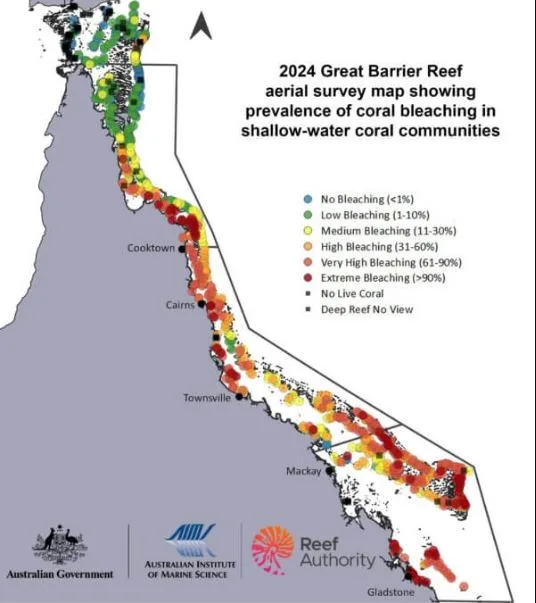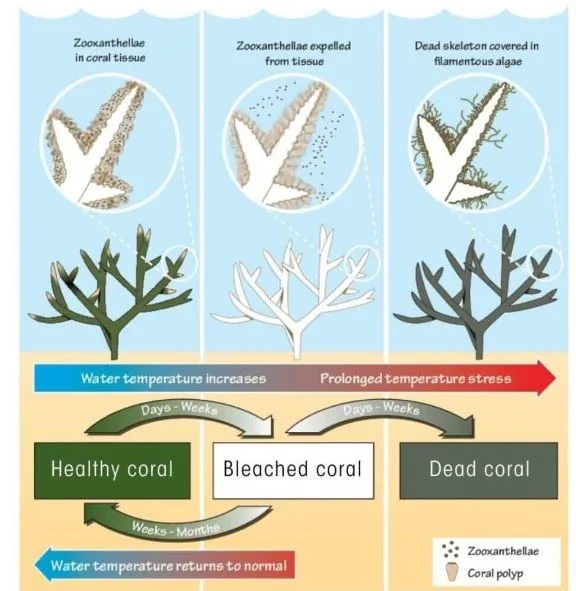Syllabus: GS3/ Biodiversity and Conservation
Context
- According to the National Oceanic and Atmospheric Administration (NOAA), the mass bleaching of coral reefs around the world since 2023 is now the most extensive on record.
About
- 77% of the world’s coral reef areas – from the Atlantic to the Pacific to the Indian oceans – have so far been subjected to bleaching-level heat stress.
- The NOAA coral reef authority declared the global bleaching event in 2024, making it the fourth of its kind since 1998.
- Mass bleaching events on the Great Barrier Reef have been documented with full-scale surveys in 1998, 2002, 2016, 2017, 2020, 2022 and 2024.
- The previous record from the 2014 to 2017 mass bleaching affected just below 66 percent of the world’s reef area.
- In coming months and years scientists will conduct underwater assessments of dead corals to help tally up the severity of the damage.

What are Corals?
- Corals are invertebrates that belong to a large group of animals called Cnidaria.
- Corals are formed by multiple small, soft organisms known as polyps.
- They secrete a rocky chalk-like (calcium carbonate) exoskeleton around themselves for protection.
- Coral reefs are therefore created by millions of tiny polyps forming large carbonate structures.
- Appearance: Corals range in colour from red to purple and even blue, but are most commonly shades of brown and green.
- Coral are bright and colorful because of microscopic algae called zooxanthellae.
- There are three types of coral reefs – fringing reefs, barrier reefs and atolls.
- Fringing reefs form along shorelines, barrier reefs form in open water and atolls are circular reefs that have formed around sunken volcanoes.
- Significance: They provide food, shelter, resting and breeding grounds to a quarter of all marine life, acting as nurseries and refuges to protect critical biodiversity.
- They also support more than 1 billion people living in coastal regions around the world by providing food, livelihoods and recreation.
Coral Bleaching
- Coral bleaching occurs when corals expel the colourful algae living in their tissues.
- Without these helpful algae, the corals become pale and are vulnerable to starvation and disease.
- A bleached coral is not dead, but ocean temperatures need to cool off for any hope of recovery.
- At least 14% of the world’s remaining corals were estimated to have died in the previous two global bleaching events.
- Scientists had previously projected that coral reefs would cross a tipping point at 1.5 degrees Celsius (2.7 F) of global warming, whereby up to 90% of reefs would be lost.
- The latest record bleaching adds to growing evidence that reefs have already passed a point of no return at just 1.3 C (2.3 F) of warming.
What triggers Coral Bleaching?
- The leading cause of coral bleaching is climate change.
- A warming planet means a warming ocean, and a change in water temperature—as little as 2 degrees Fahrenheit—can cause coral to drive out algae.
- Coral also bleaches for other reasons, like extremely low tides, pollution, or too much sunlight.
- The ongoing bleaching has been made worse by El Nino, a natural climate pattern that can temporarily warm some oceans, which ended in May.
Concerns
- Coral bleaching matters because once these corals die, reefs rarely come back.
- With few corals surviving, they struggle to reproduce, and entire reef ecosystems, on which people and wildlife depend, deteriorate.
- This would have dire implications for ocean health, subsistence fisheries and tourism.
Impact of Coral Bleaching
- Wildlife: Thousands of marine animals depend on coral reefs for survival.
- Coral reefs provide shelter, spawning grounds, and protection from predators.
- They also support organisms at the base of ocean food chains.
- As reef ecosystems collapse, already at-risk species may face extinction.
- Humans: Coral reefs are natural barriers that absorb the force of waves and storm surges, keeping coastal communities safe.
- Every year, reefs provide about $2.7 trillion in goods and services, according to a 2020 estimate by the Global Coral Reef Monitoring Network.
- Bleached coral also compounds the overfishing crisis by removing links in the food web and depriving some fish of a place to spawn and develop.
- Reef tourism brings in billions of dollars each year and supports thousands of jobs.
Can corals recover from bleaching?
- Corals can recover from bleaching over time, but only if temperatures drop and conditions return to normal.
- When this happens, the algae returns and the corals gradually regain their health.

Way Ahead
- Strengthening Marine Protected Areas (MPAs).
- Implementing coral restoration techniques, such as coral gardening and breeding resilient coral species, to enhance recovery after bleaching events.
- Advocating for global efforts to reduce greenhouse gas emissions to limit temperature increases and ocean acidification.
- Increasing investment in research to better understand coral resilience, bleaching triggers, and recovery processes, alongside developing advanced monitoring technologies.
Source: TH
Previous article
COP 16 of Convention on Biological Diversity
Next article
News In Short 23-10-2024